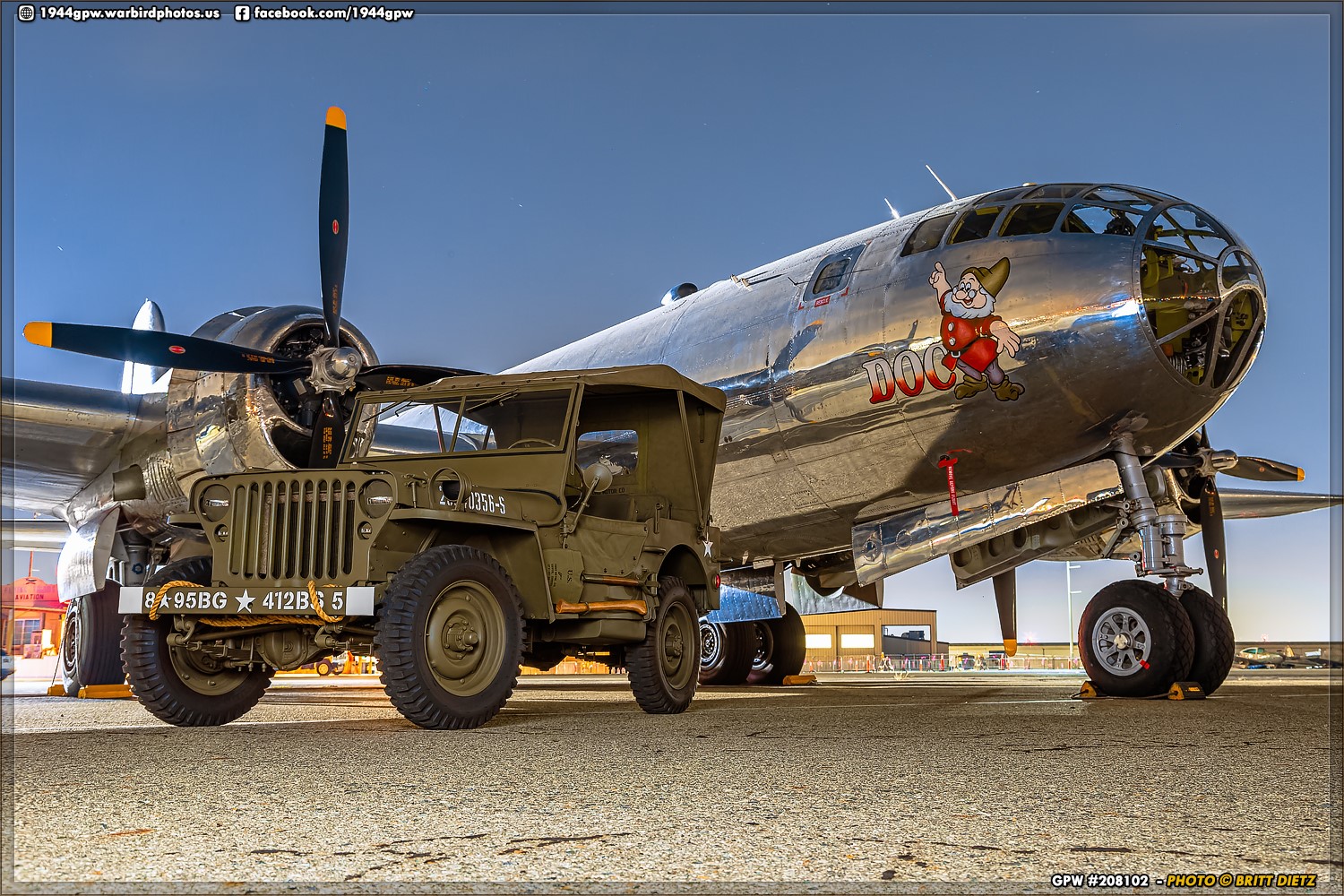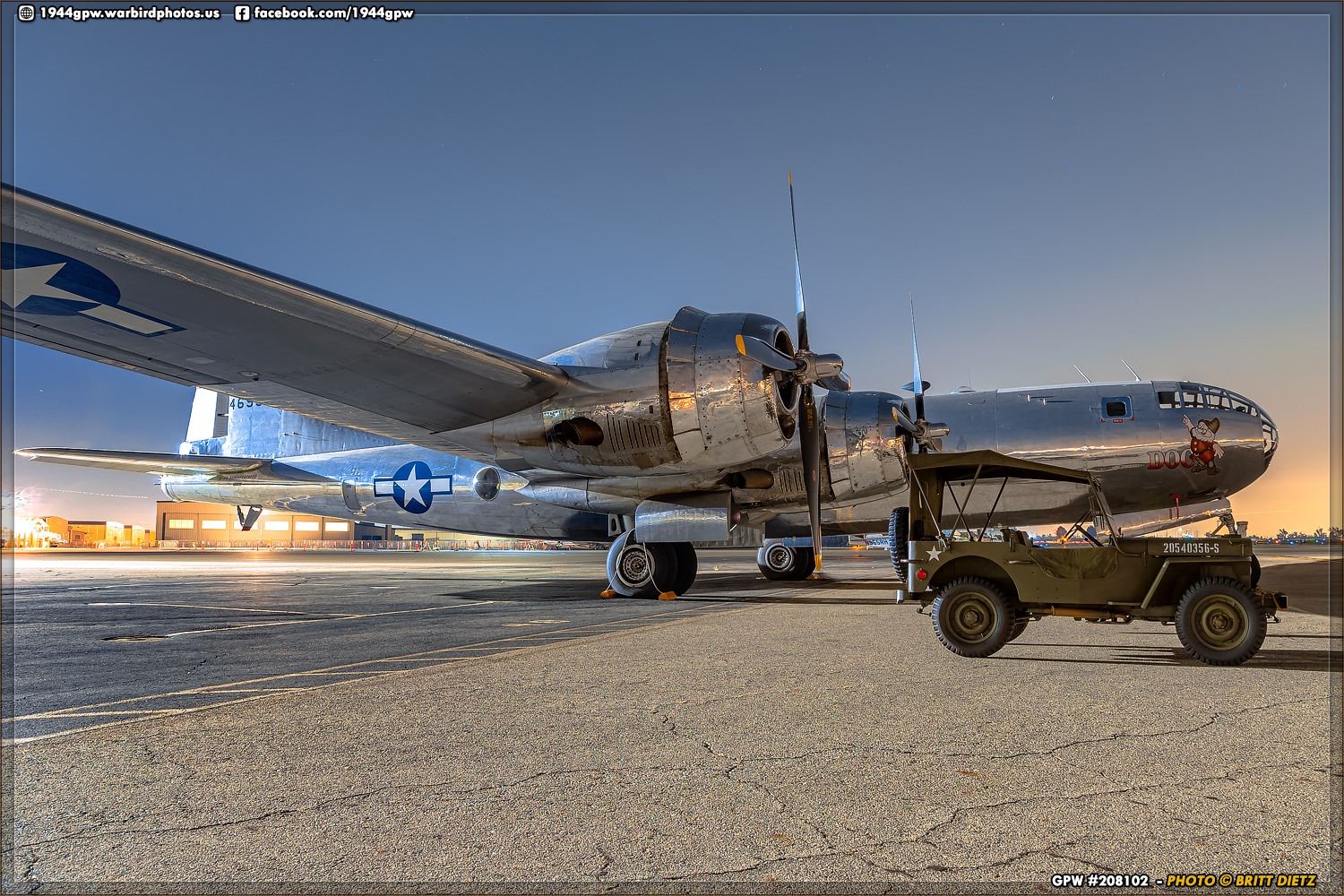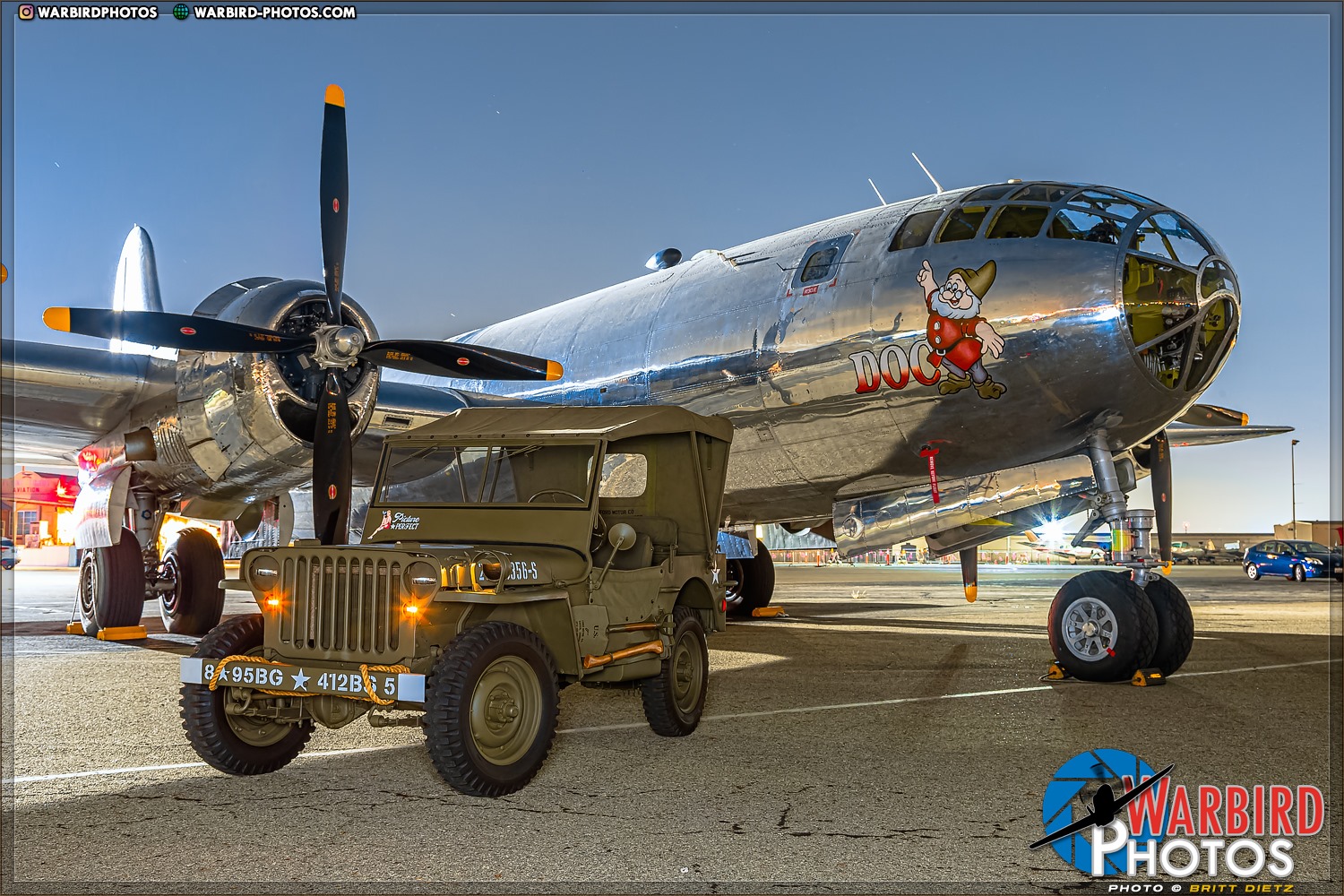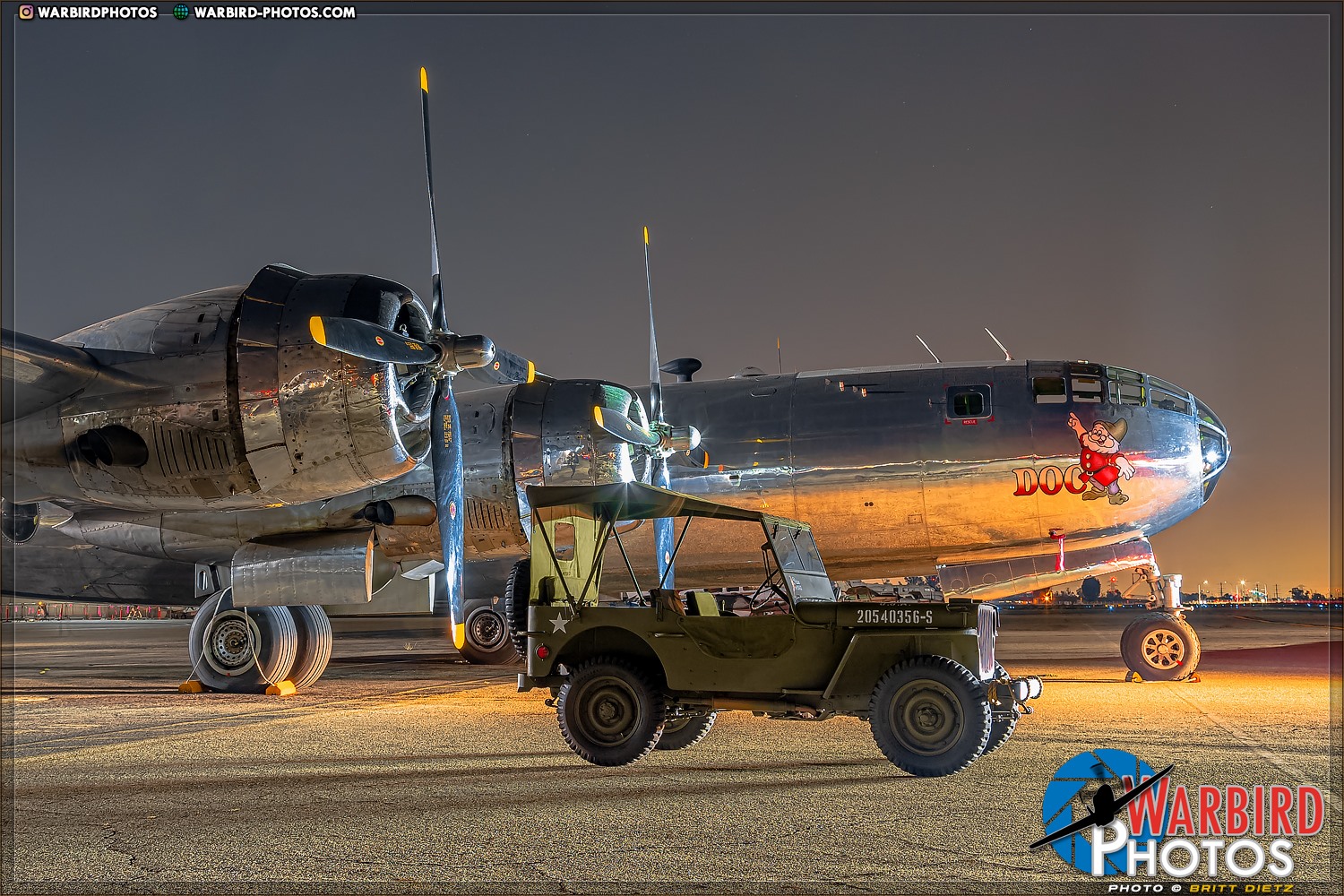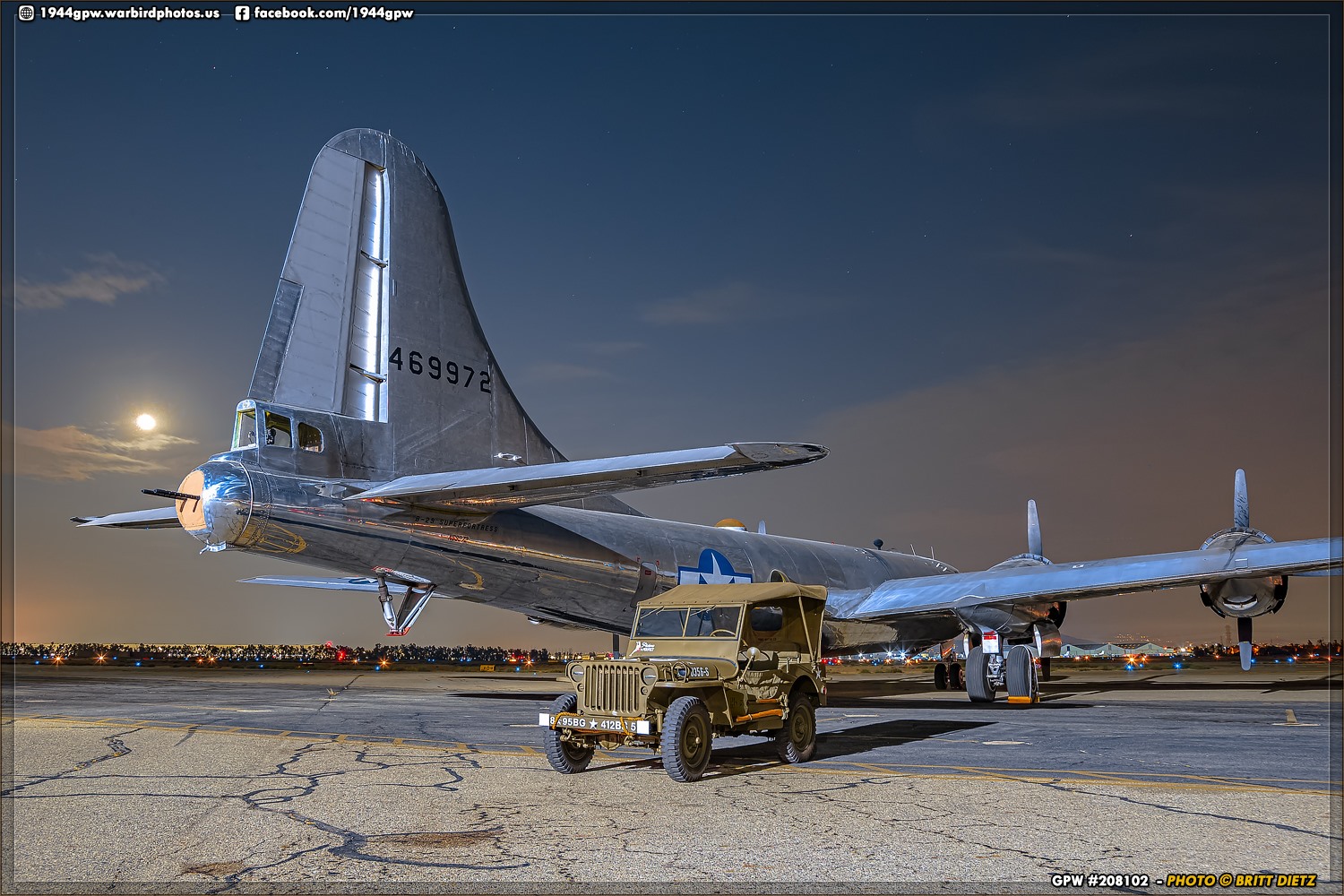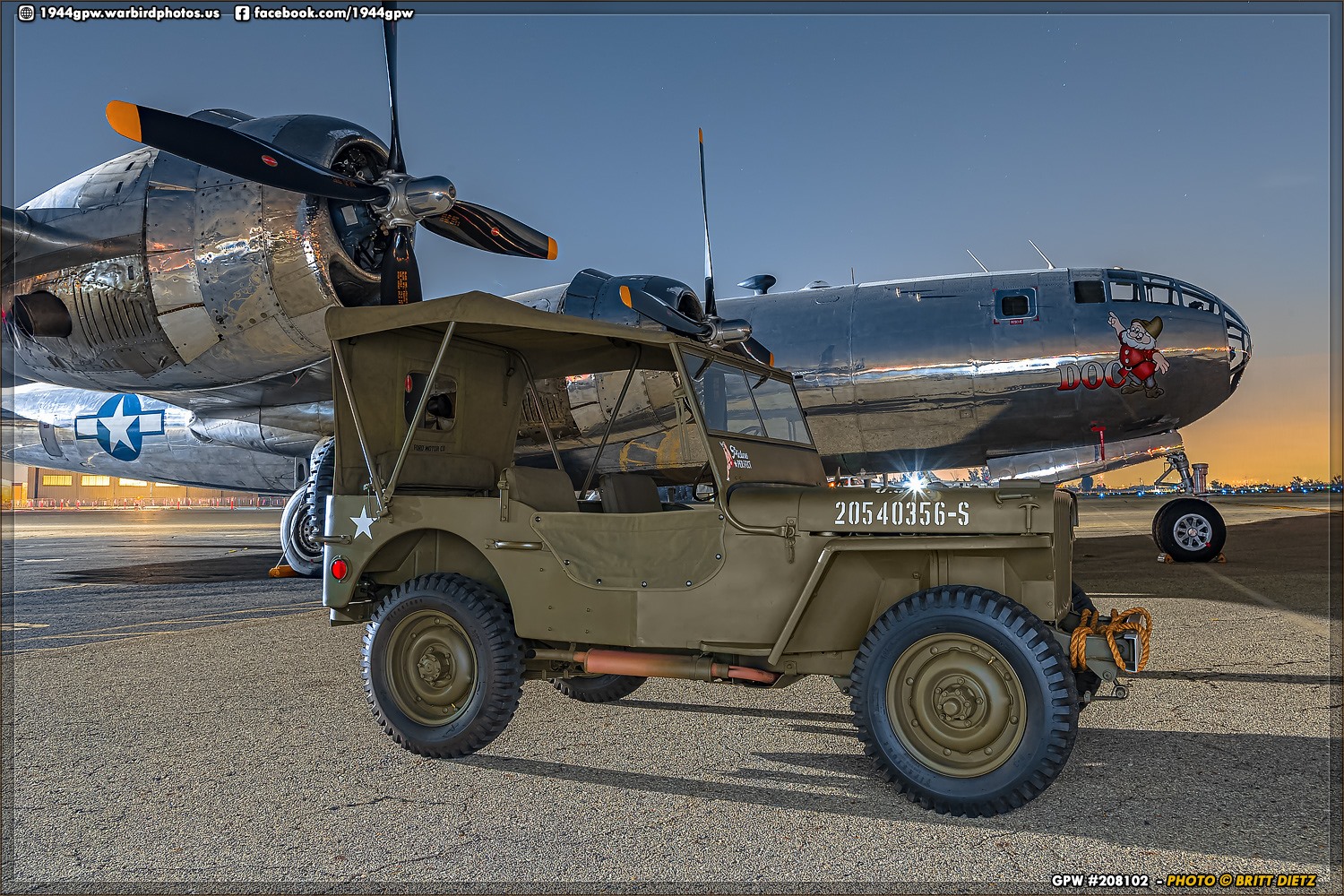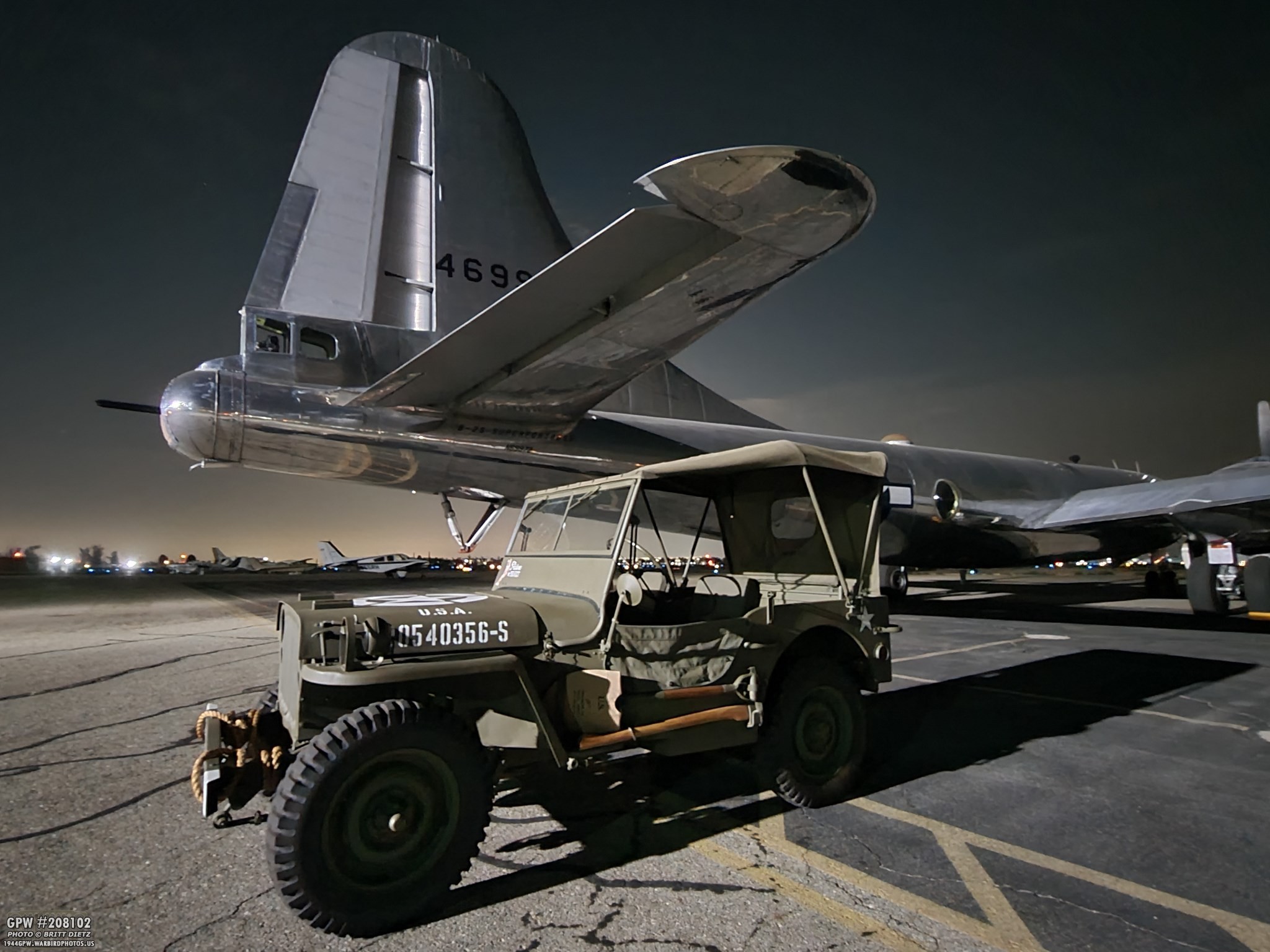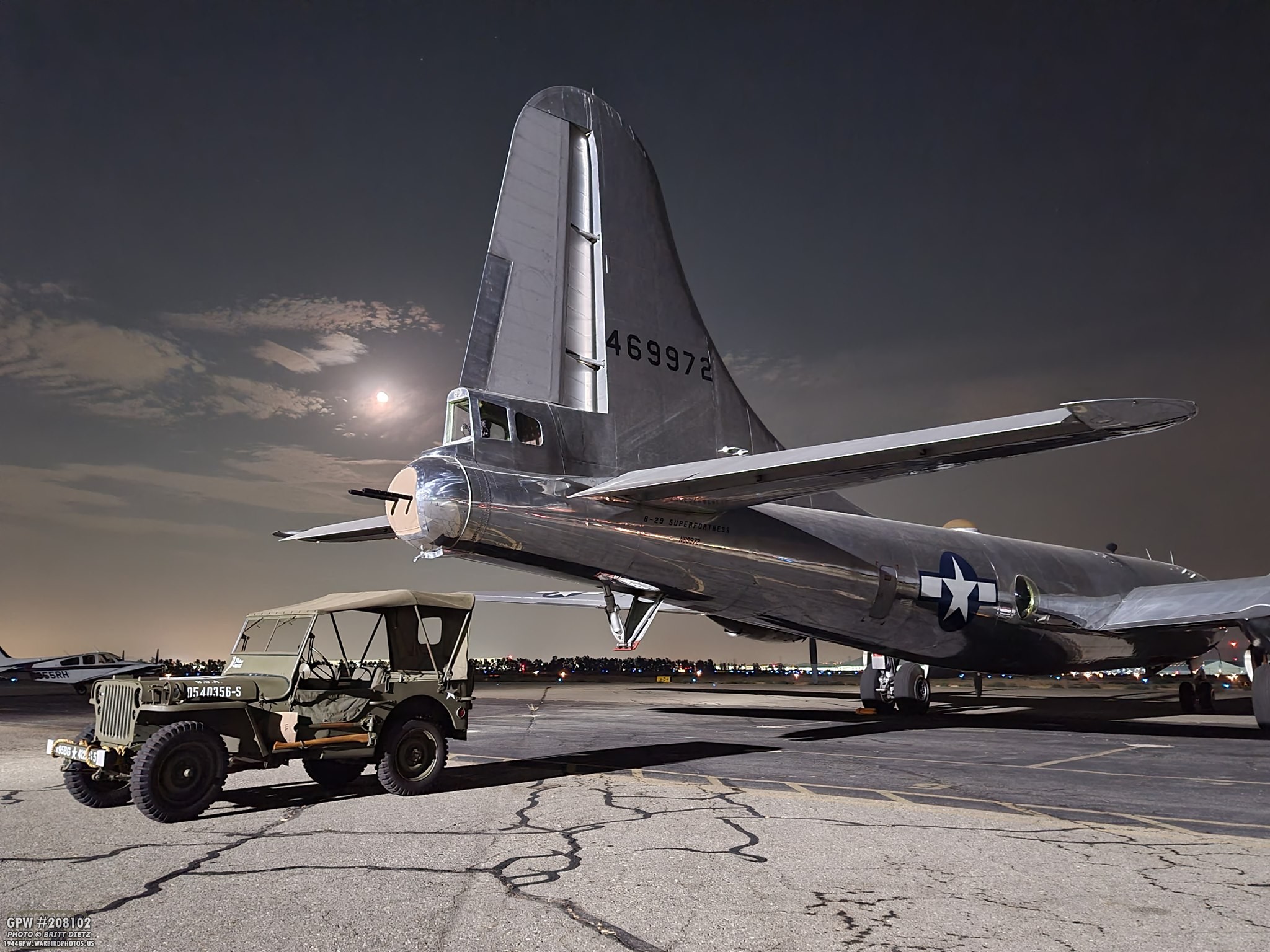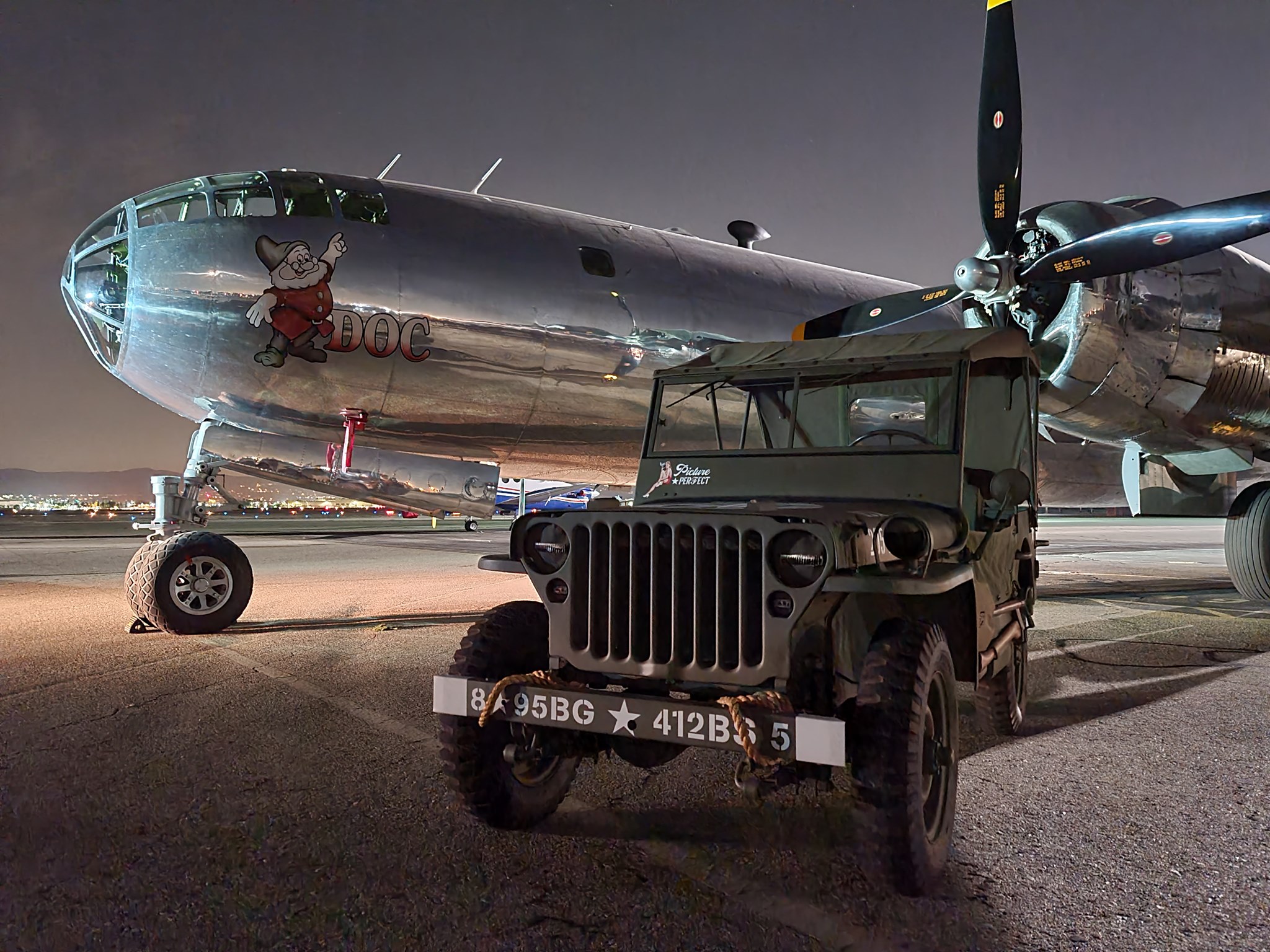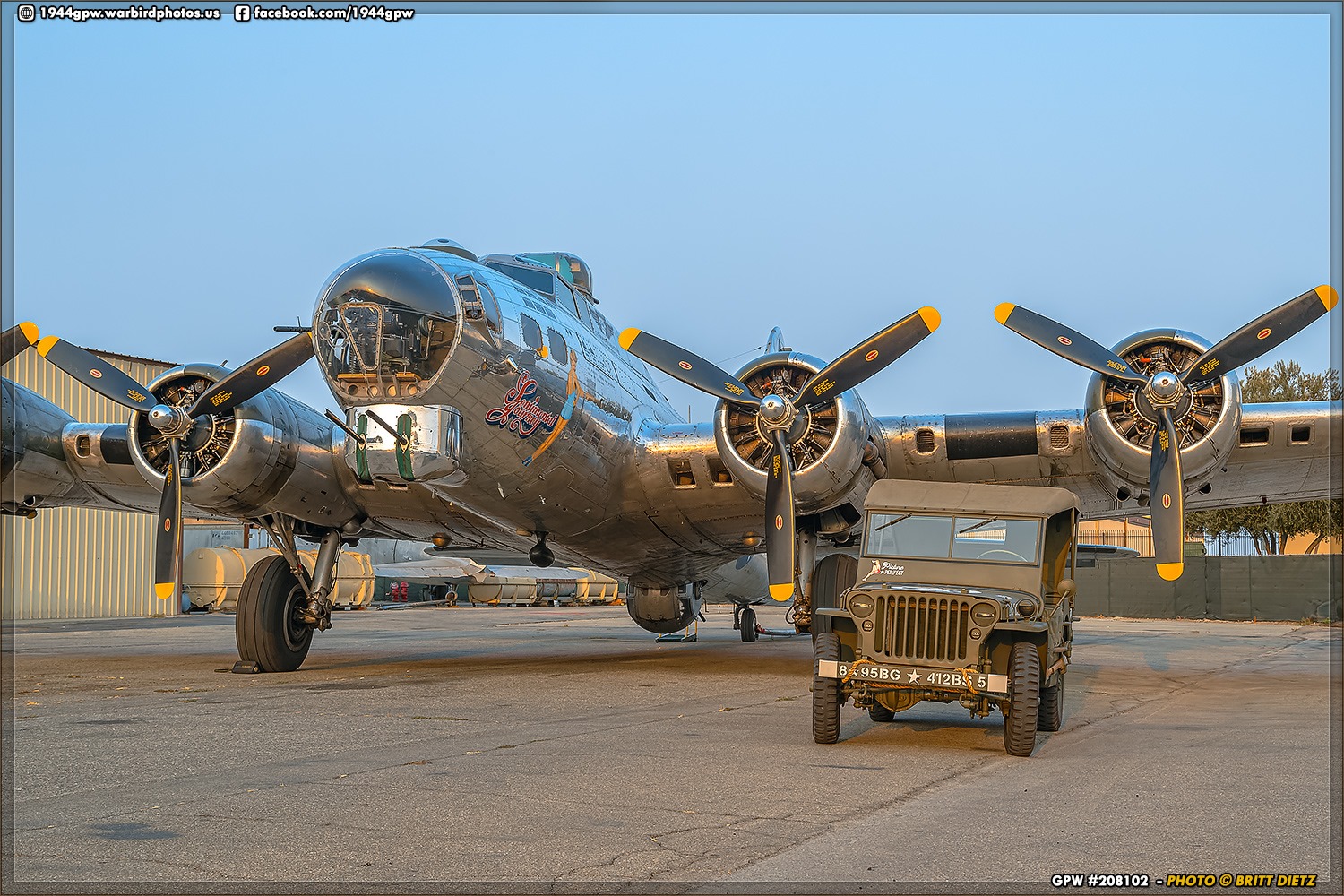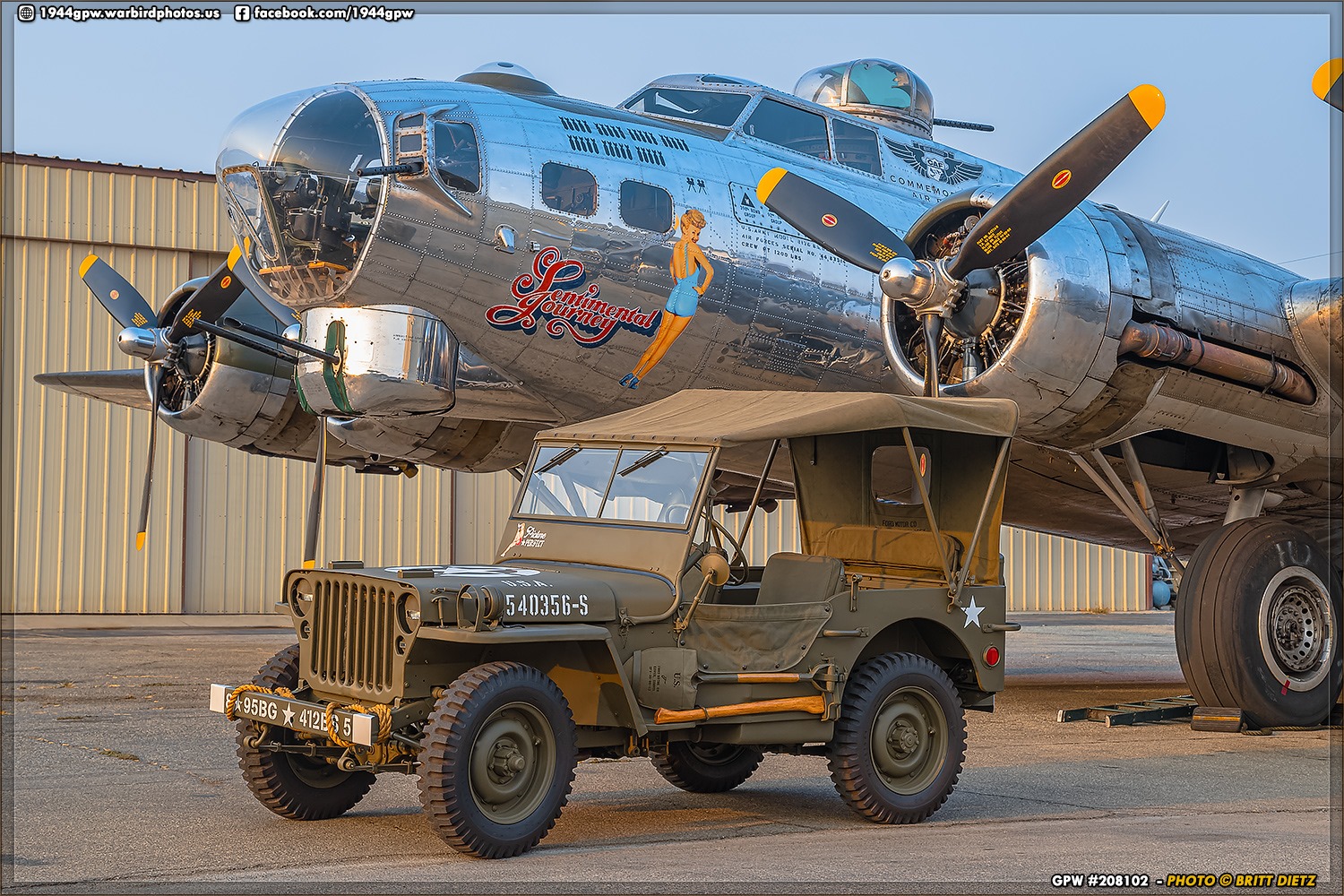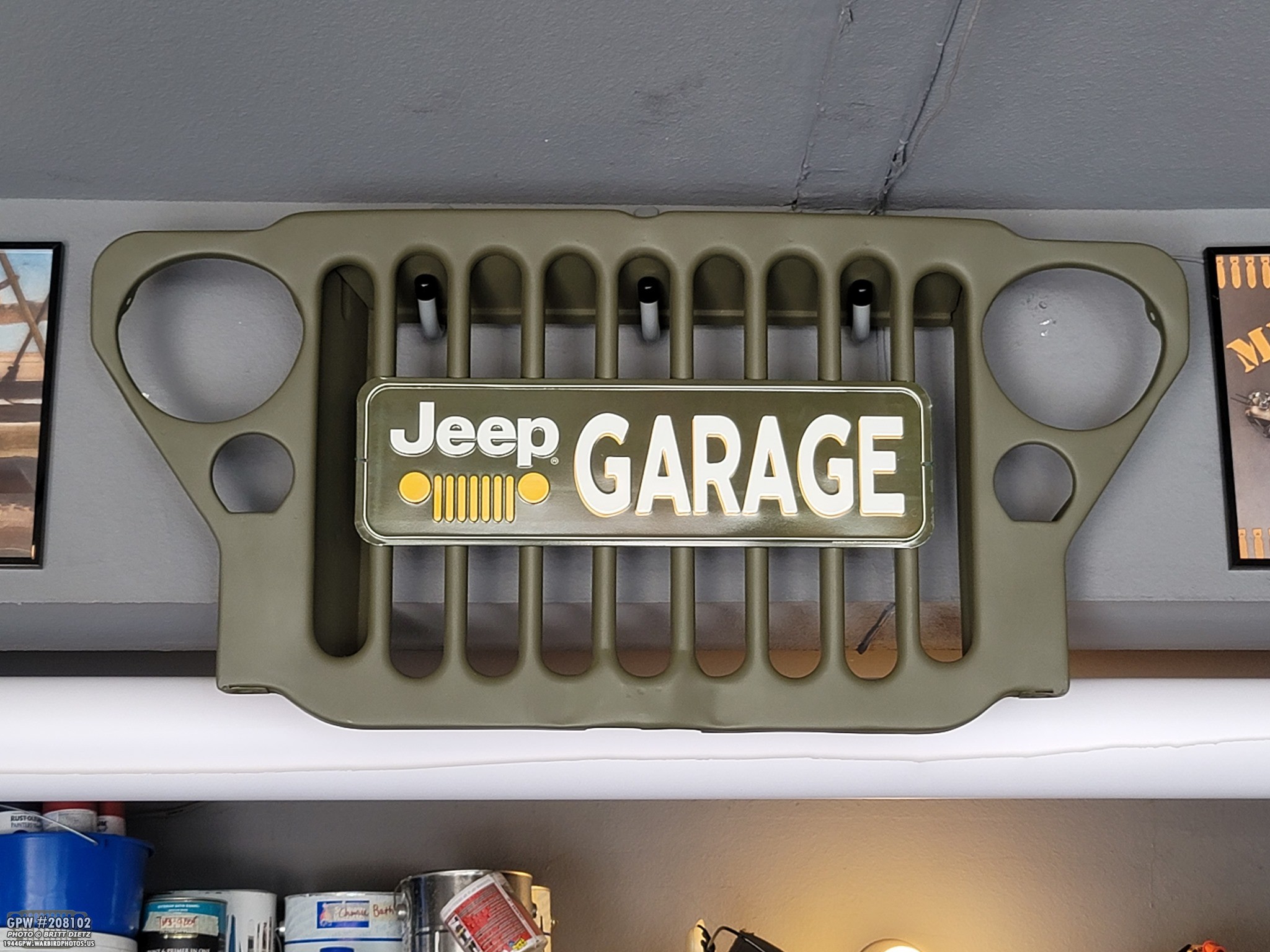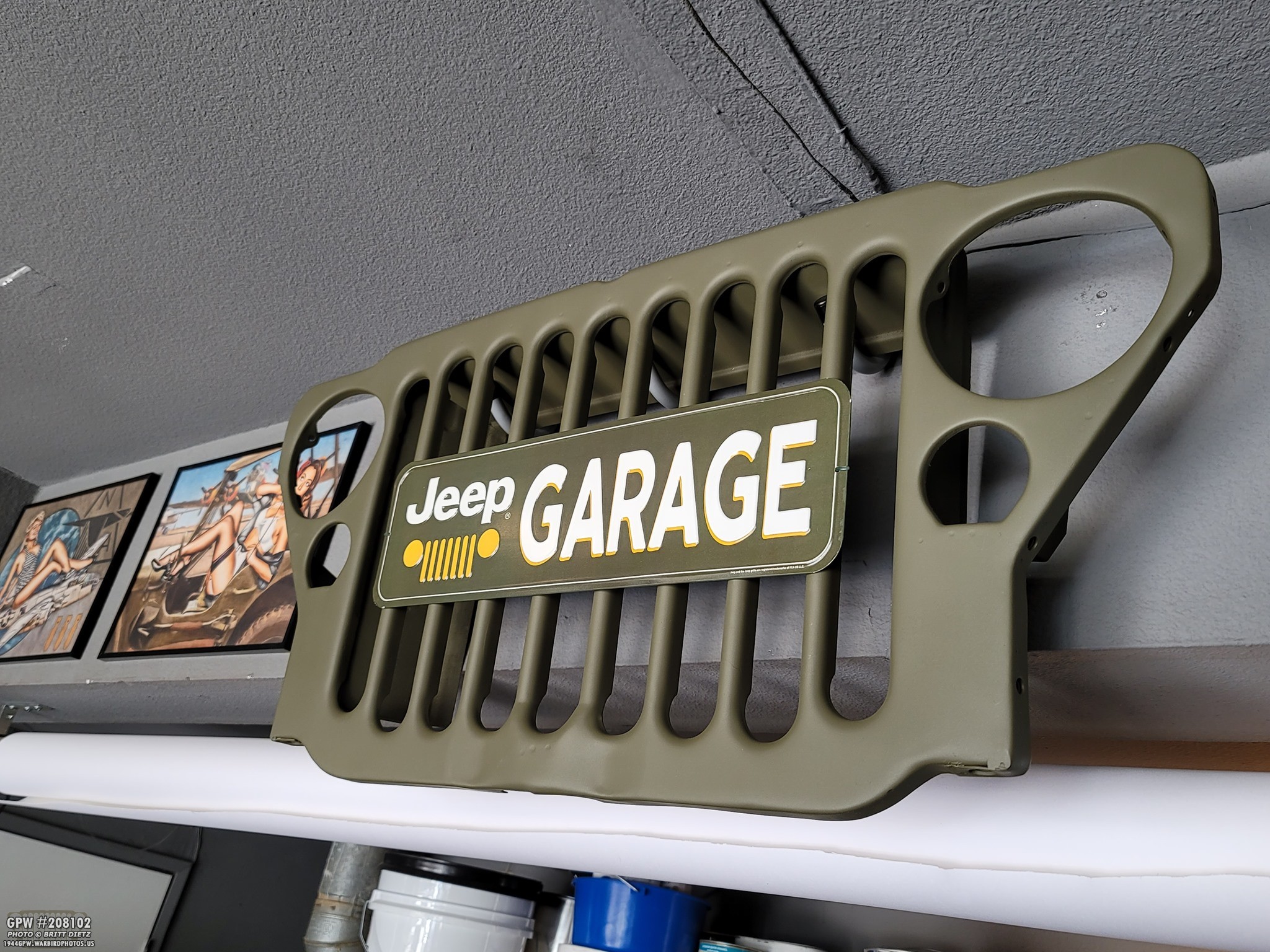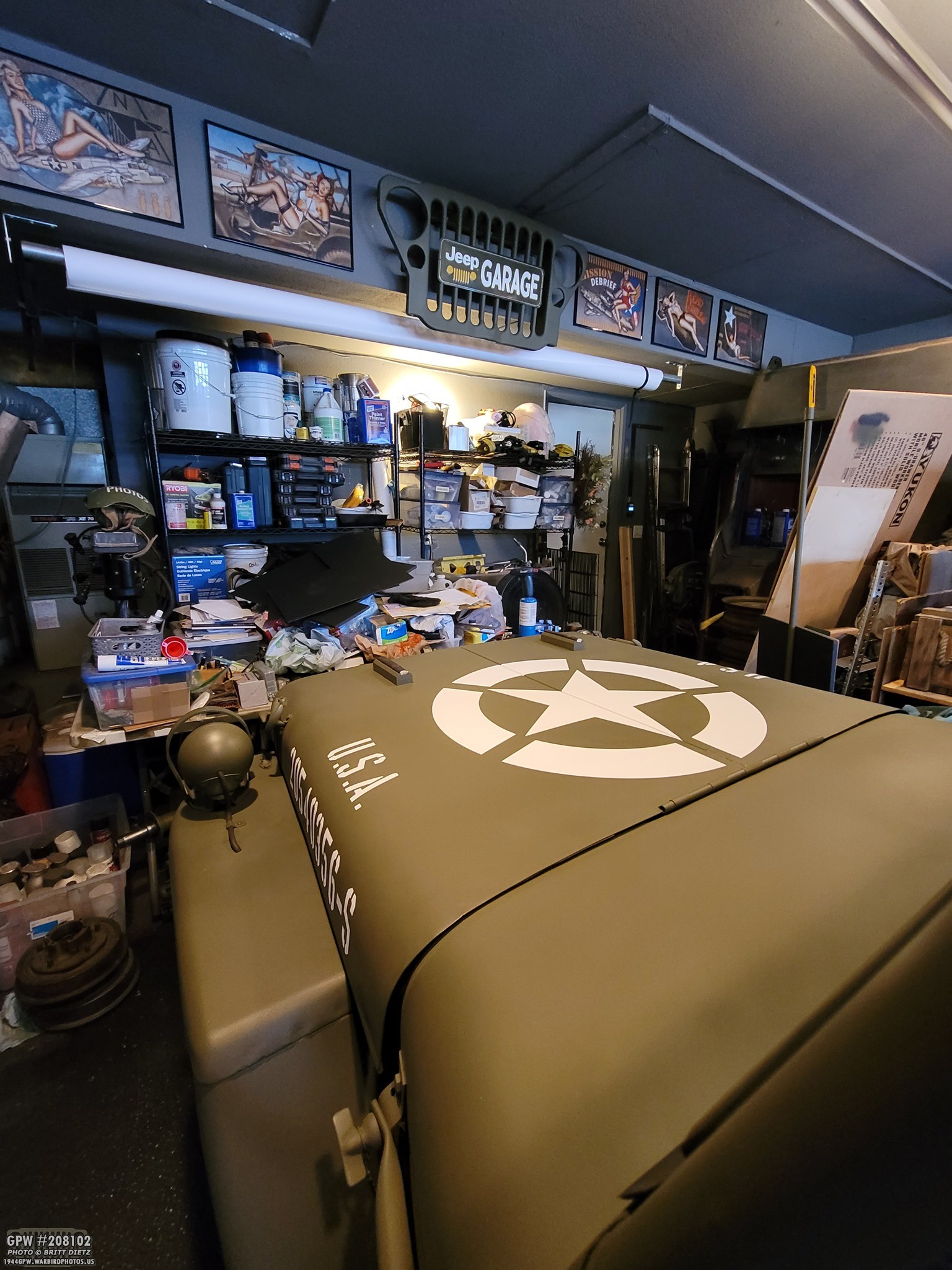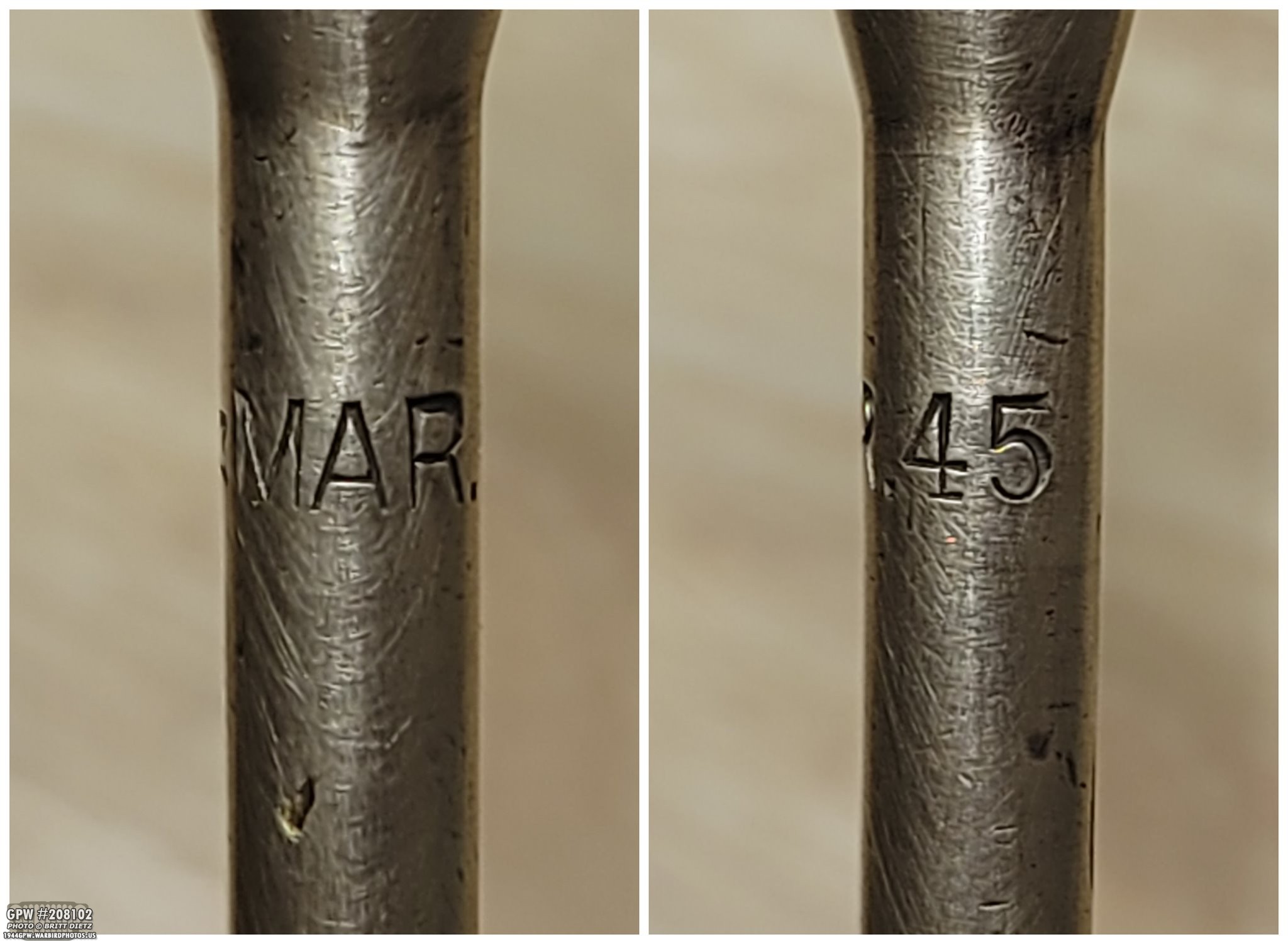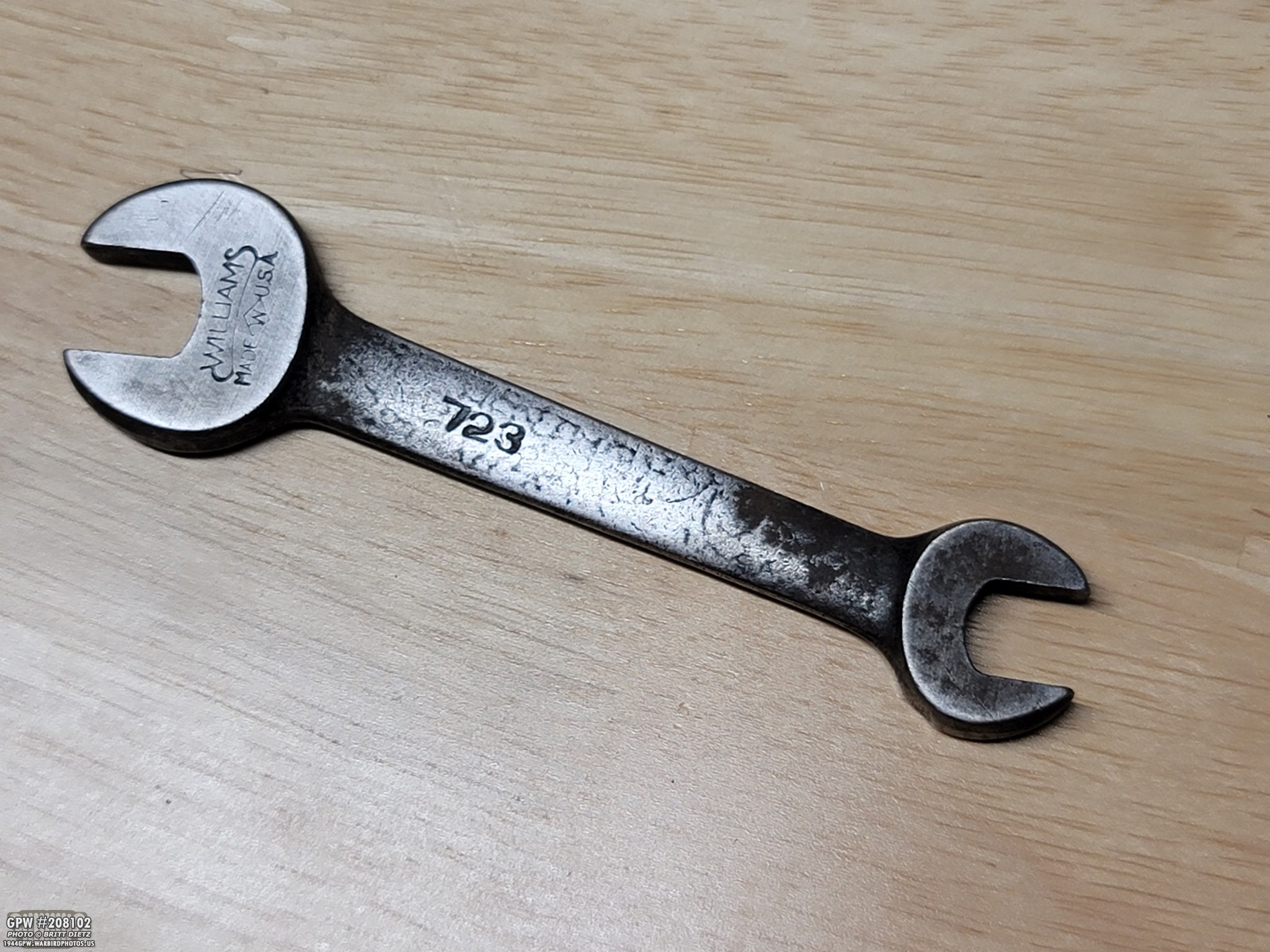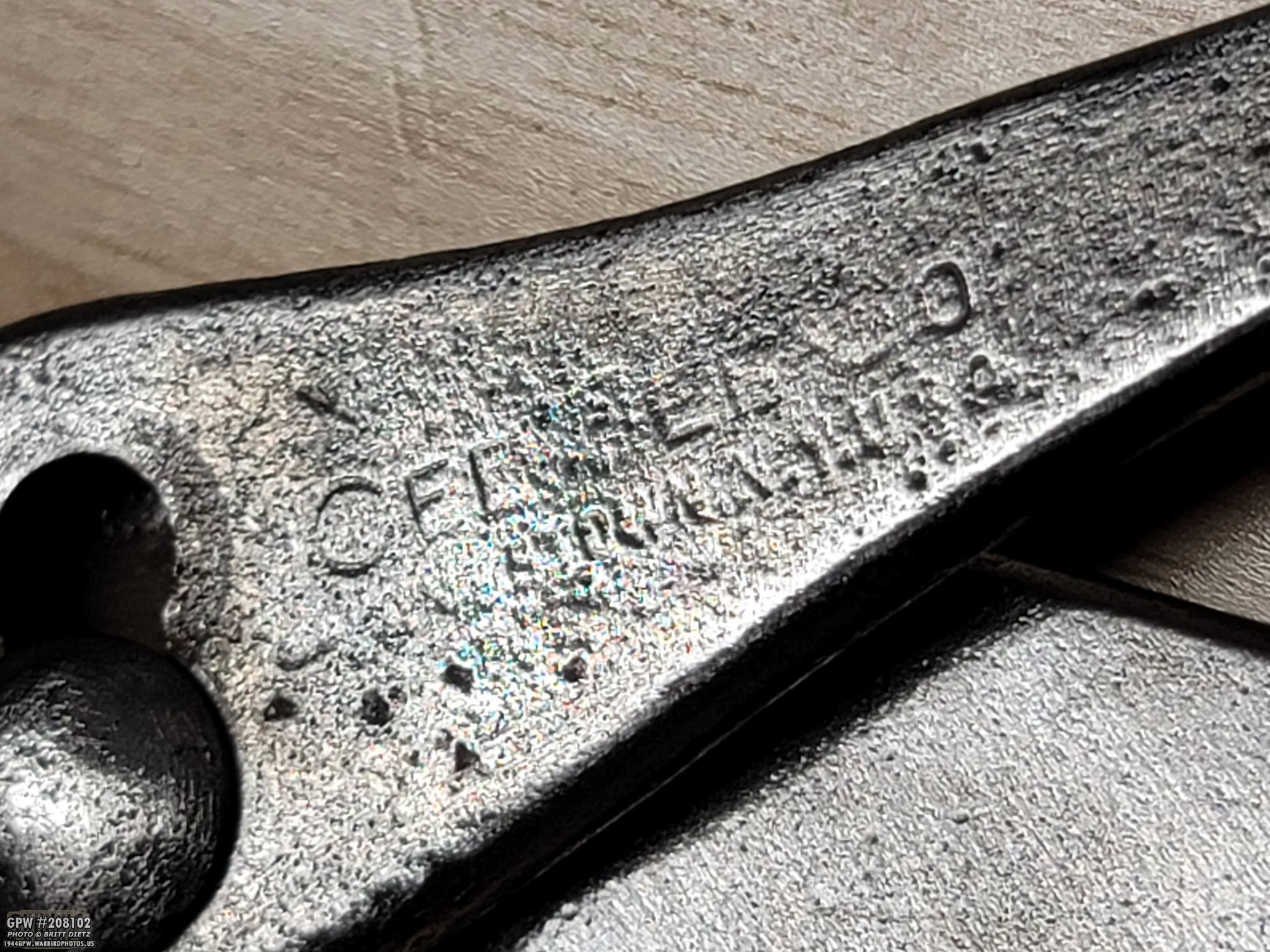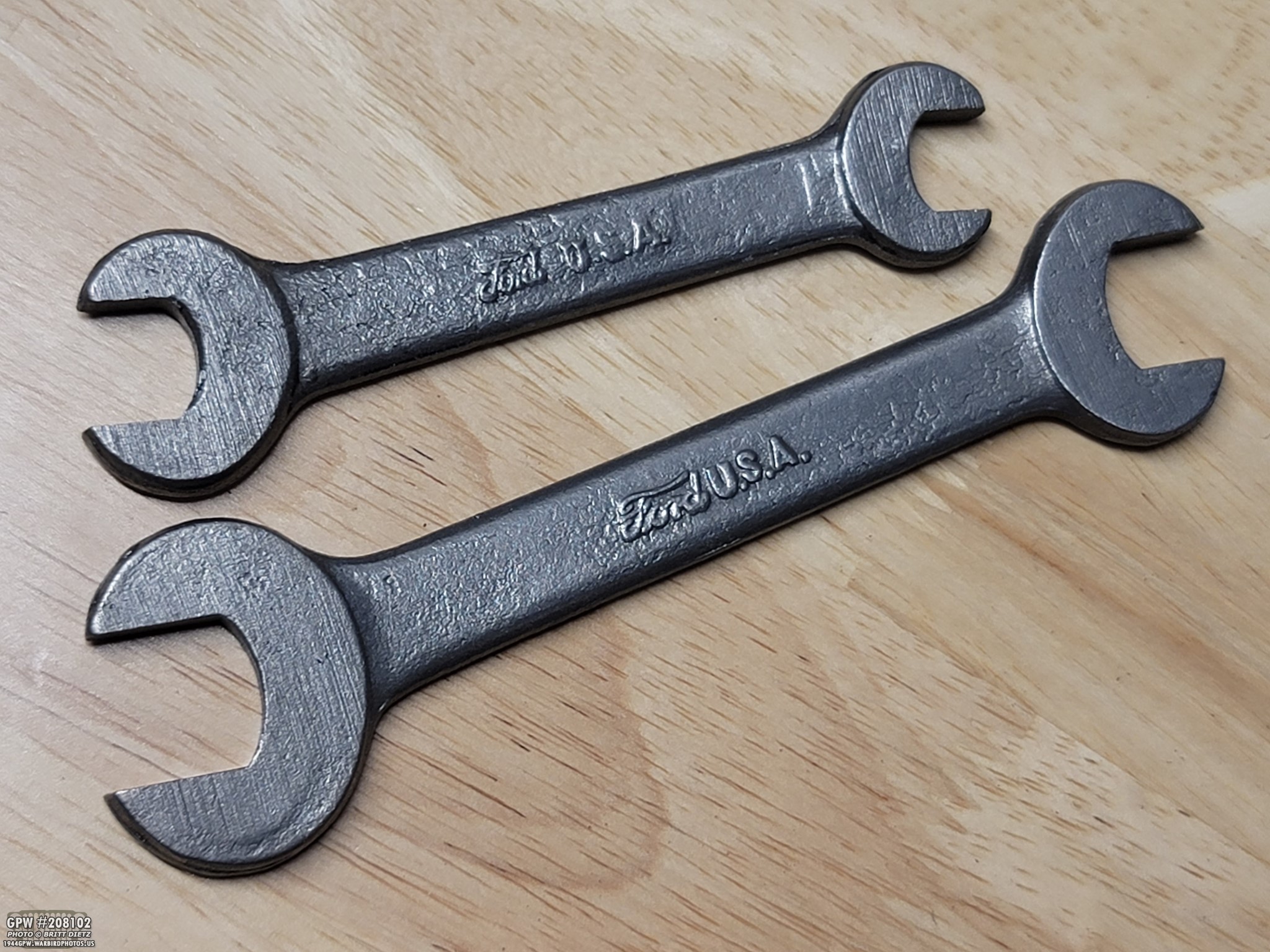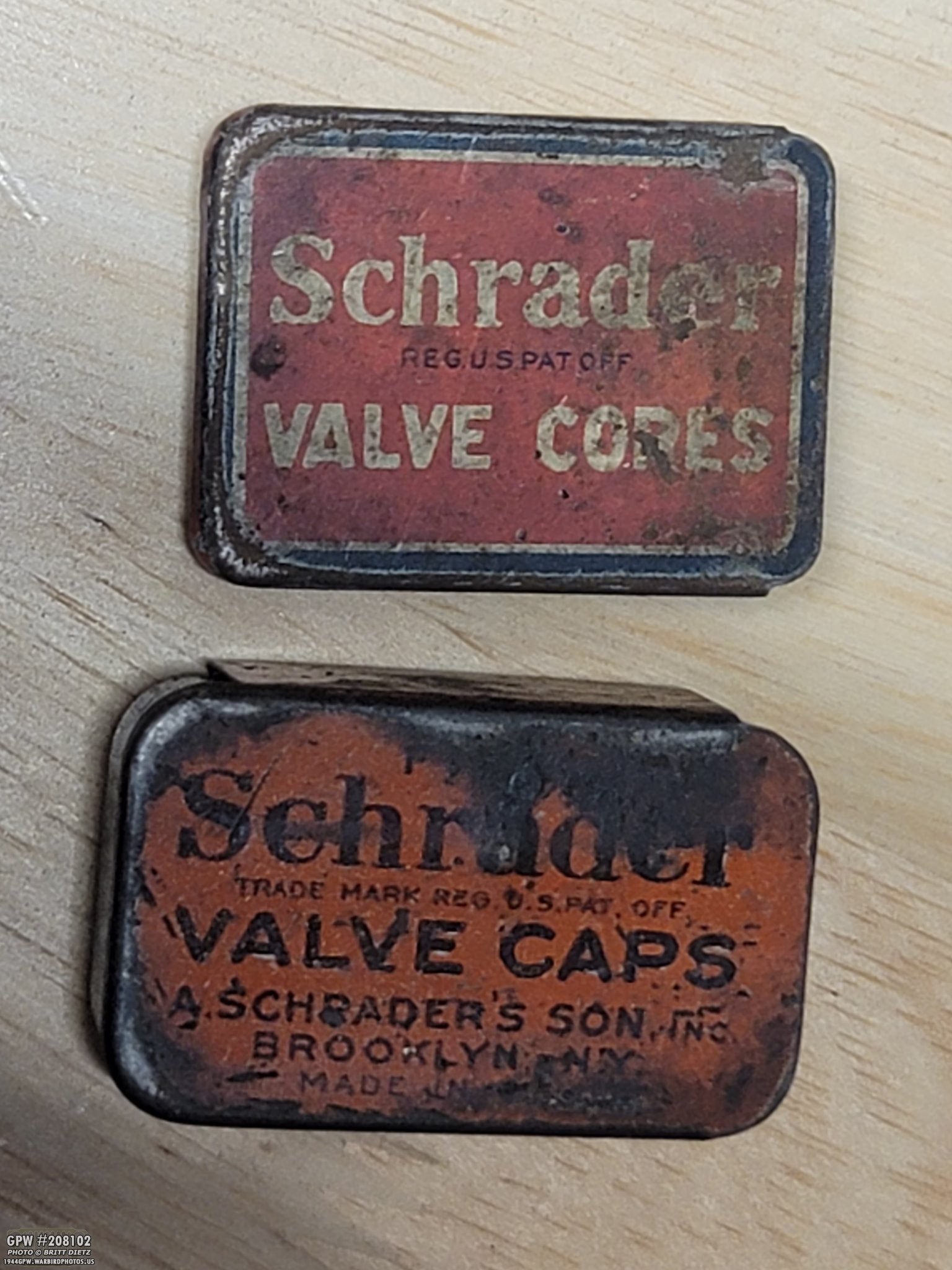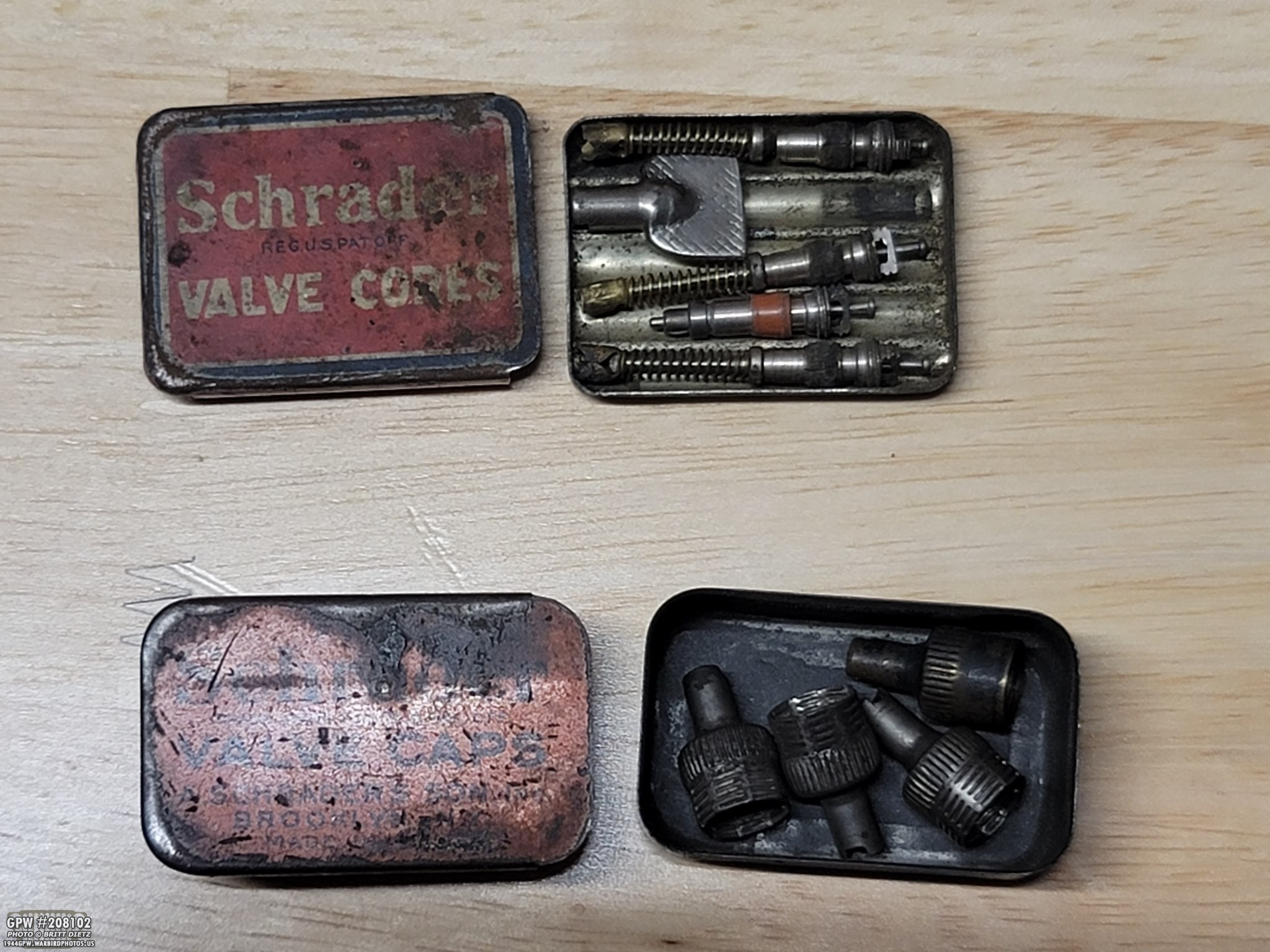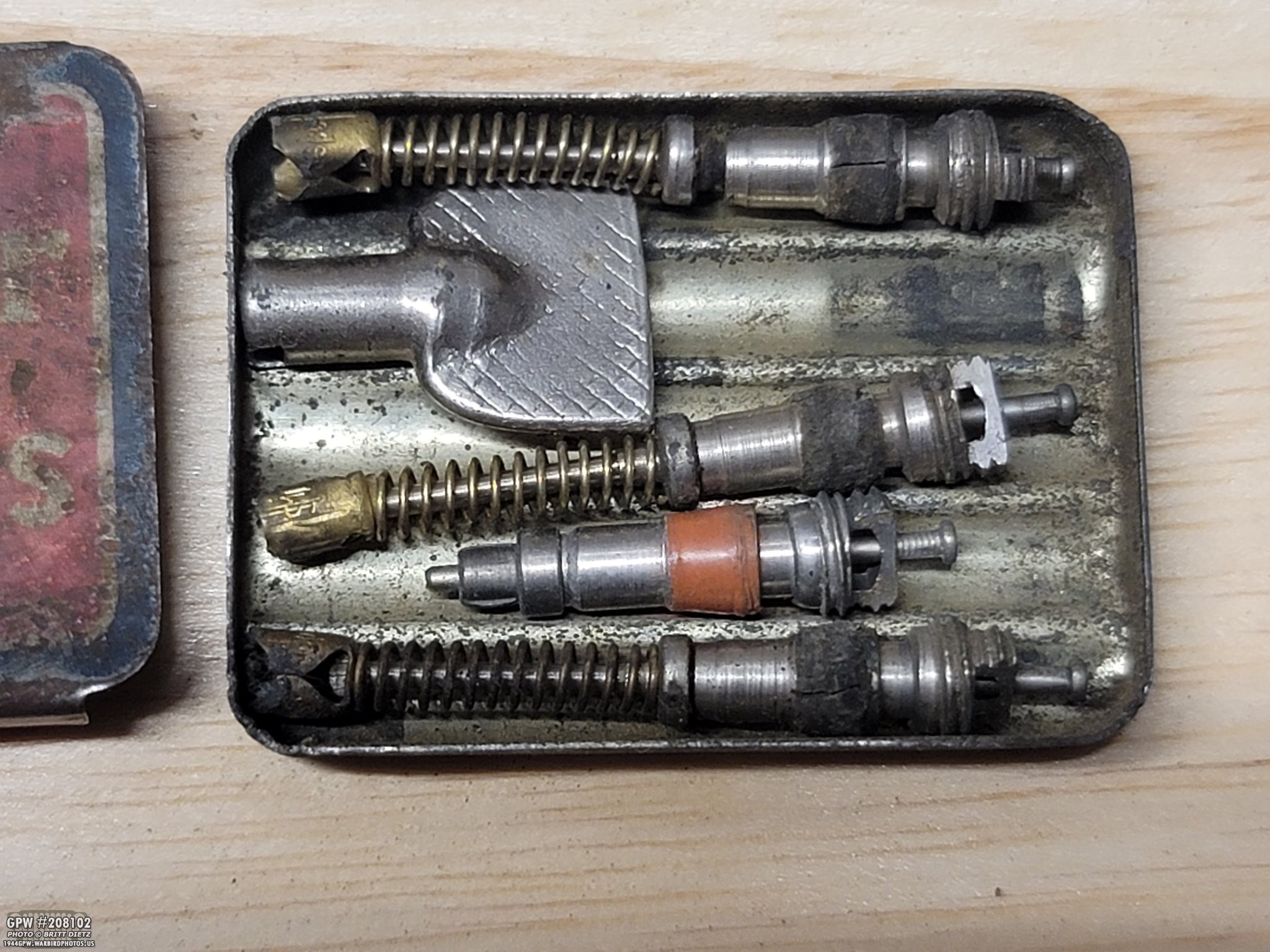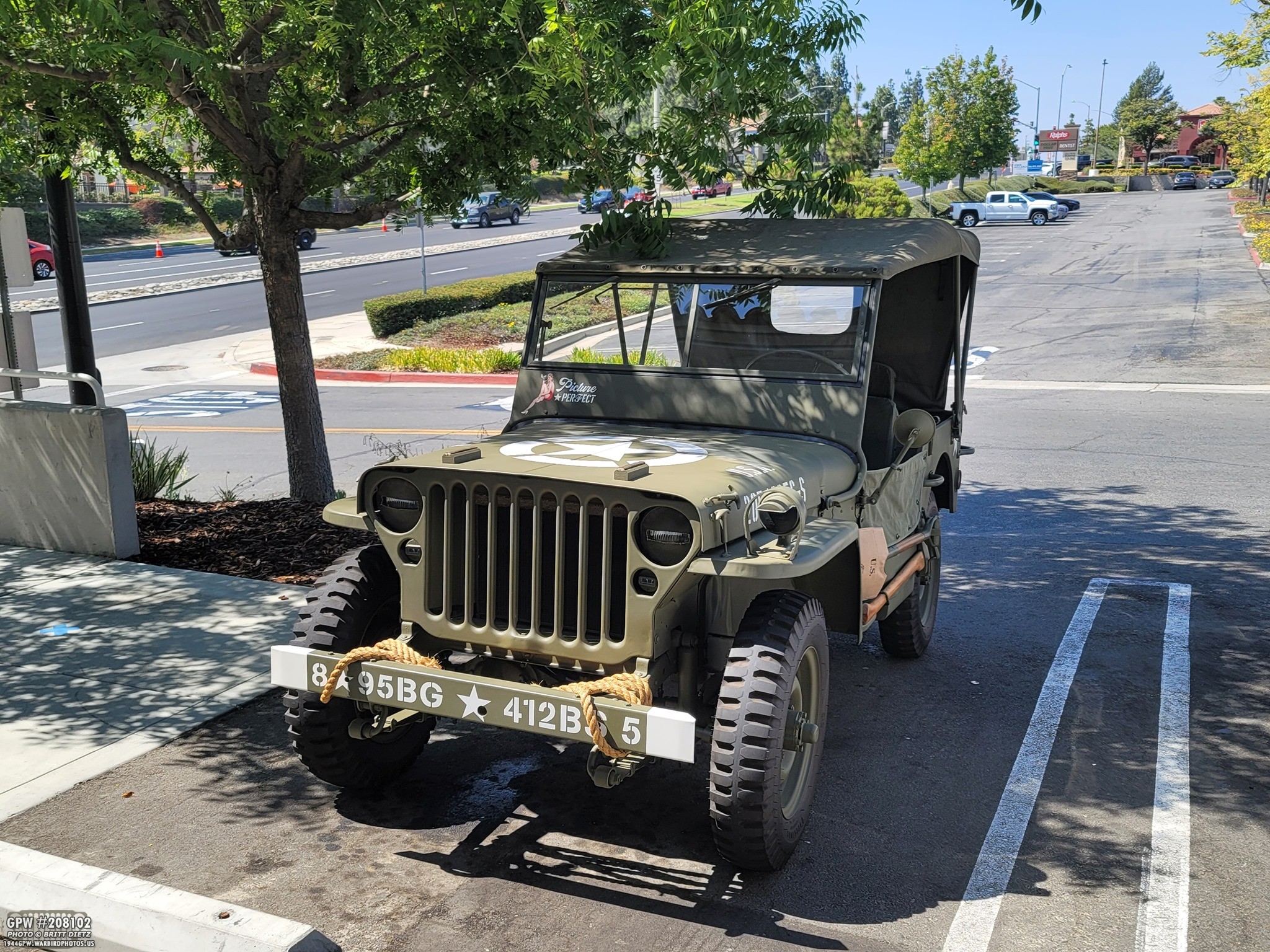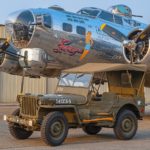 WW2 Bombers, MD Juan Grill Display, and Flea Market finds
WW2 Bombers, MD Juan Grill Display, and Flea Market finds
It’s been a while since the last full update, so here’s a special one with what all has happened in the last month! First, the Jeep got to meet two incredible World War 2 bombers including a B-29 Superfortress and a B-17 Flying Fortress! Lots of photos with both the aircraft. Then, I finished the MD Juan grill display that I had worked on in August which is now hanging in my garage. Finally, various flea market finds including tools and how to identify correct Schrader screw type tire valve caps.
Kicking off the post with a bang, a preview of the ‘main event’ these past few weeks getting to take photos of my Jeep with a Boeing B-17G Flying Fortress! More on that in a few, but first let’s talk about another bomber that passed through the area….
Two weeks ago a very rare bird graced the skies over Chino Airport, California. One of only two Boeing B-29 Superfortress aircraft still flying in the world, the famous ‘Doc’ came to Yanks Air Museum during a tour stop in late September.
It took a bit of wrangling trying to figure out where they’d park her, as for the first few days of her visit she was parked in the darkest area of the airport. My chance to shoot with her came when I got word she was moved near the tower of the airport in prep for the next day’s paid flights. So, I hopped into the Jeep and headed out in the evening to the airport!
I typically don’t like driving the Jeep at night as the only brake light is the standard driver’s side one that is very hard for other drivers to see, so I had my girlfriend follow me in her car to keep some distance between speeding motorists. And I couldn’t pass up this opportunity to shoot with a B-29 Superfortress!
Even though it was about 830pm at night, it was warm out, and other were a lot of airport tenants coming out to take a peek at the B-29, so the shoot was paused a few times as I wanted for people to walk out of the shot. But everyone was also really interested in my Jeep so I was able to strike up a few conversations!
Here a truck pulled up with their headlights highlighting the B-29. I thought it was interesting lighting and helped illuminate my Jeep. I can imagine Jeeps out somewhere in the Pacific on an airfield taking the pilots to their aircraft for a night mission.
Of all the photos with Doc, this one was my favorite with the moon rising over Riverside in the distance. It just shows how massive that B-29 tail is! It’s always fun to have a rare aircraft like this pretty much all to yourself.
It’s tough shooting the right angles to not get all the airport clutter in the background. Chino Airport can be pretty packed with general aviation aircraft overnight on the ramp. I flipped the headlights on for this one.
This angle is a lot better with just the runways and the distant cityscape in the background. If only they’d turned Doc around! 😛
Doc and my Jeep were built in the same year, 1944. She was delivered to the Us Army Air Force in March of 1945 but never saw any combat during the war.
Post-war in 1951, she and a few other B-29s were assigned radar calibration duty and each of the aircraft were given a name of one of the Disney Seven Dwarfs from Snow White. By 1955 the aircraft became bomb targets for training aircraft out in China Lake, California.
Note – My camera battery died (DOH! Forgot to charge it), so the rest of the photos are with my phone.
42 years after being in the desert as a target for aircraft, Doc was found in 1987 and the decision was made to get her out of there and restore her to flight.
It took 12 years and a lot of red tape before she was finally removed from the desert. Doc and the other flying B-29 ‘Fifi’ were taken out of the same desert. She was moved to Wichita, Kansas for restoration at the same Boeing facility she was built during the war.
It wasn’t until June of 2016 that Doc was made airworthy with her first flight in July 2016. Since then she’s toured all around the United States visiting airshows and airports.
I was glad to have this chance to get some shots of my Jeep with this rare aircraft adding to the roster of all the WW2 aircraft my Jeep has taken photos with. Up until this point, I had only shot with a B-25 Mitchell and the Planes of Fame Air Museum’s under long-term restoration B-17 behind a gate as far as bombers go. So getting the heaviest of all US WW2 bombers is quite a treat! Thanks for the help making this happen Yanks Air Museum!
And right after Doc ended her time at Chino Airport, another Boeing bomber came in for a tour visit, this time from the CAF Airbase Arizona. The Boeing B-17G Flying Fortress ‘Sentimental Journey’ stopped at the Planes of Fame Air Museum for a week. I know it might seem weird to say I was more excited for this aircraft to get to the airport than a B-29 Superfortress, but I’ll explain in a bit.
As a volunteer photographer/social media creator at Planes of Fame Air Museum, I drove the Jeep out for the arrival braving the warm weather because I had to get photos with the B-17. Weather caused the B-17 to be late getting to the museum, and by the time they had locked her up and she was clear of people, it was almost sunset so I had to work fast.
I spent about an hour moving my Jeep around this beauty getting shots from various angles. Even though the light was fading (and there were some low-level marine layer clouds behind me the setting sun was popping in and out of, the photos still came out amazing.
So, why was I more excited about a B-17 (one I’ve seen and photographed at airshows many times) over one of two B-29 Superfortress aircraft flying in the world? Well, take a look a the bumper of my Jeep. My Jeep is marked up as a US Army Air Force airfield Jeep from the 8th Air force, 95th Bomb Group, 412th Bombardment Squadron. The 95th was based at RAF Horham in the UK during the war with… as you might have guessed, B-17 Flying Fortress aircraft. Throw in the fact that the B-17 is my favorite aircraft of all time, and this is quite an exciting shoot for me.
Ironically, the B-17 was built around the exact same time as the B-29 in late 1944. Technically, that makes my Jeep a few months older than both aircraft. ‘Sentimental Journey’ was actually built by Douglas Aircraft and just like Doc, it was accepted into Army Air Force service in March of 1944. She was actually sent to the Pacific theater during the war flying missions. She’s a bonafide combat veteran!
Post-war, she was converted to a DB-17G for use as an air-sea rescue aircraft. She was modified again in the 1950s to be a drone for nuclear weapon testing during the ‘Operation Greenhouse’ mission. She actually spent some time being radioactive because of this!
In late 1959, she was removed from storage and sold to a civilian corporation where she was once again converted, this time to a forest fire fighting water bomber where she served for 18 years.
In 1978 she was donated to the CAF Airbase Arizona. A contest was held to name the b-17, and ‘Sentimental Journey’ was selected along with a pinup of famed Betty Grable in her most famous pose. It is said that the CAF group asked Betty Grable’s widow, Harry James, for and was granted permission to use Betty.
While she was restored to a basic wartime B-17, it wasn’t until 1985 that the incredibly accurate B-17 restoration we see today was finished. She is the most complete and perfect B-17 restoration I’ve seen thus far. The attention to detail inside her is amazing.
If I’d thought about it, I would have tried to get some reenactors out in USAAF gear to get them climbing out of the Jeep! Next time…
My goal is to shoot my Jeep with each B-17 possible as they come through the Southern California area over time. I hope 2022 brings some photos with another one! But for now, I cherish these photos finally with my favorite aircraft correct for my Jeep’s markings. Thanks CAF Airbase Arizona and Planes of Fame Air Museum!
Moving on now to the project this past month… in August I talked about how I was taking a spare MD Juan grill I had and instead of selling it, I wanted to make a garage display. The grill came pre-primered with red oxide but needed some sanding and touch-ups of primer from being banged around during shipping. After that was done, I hit it with 33070 OD Green like my Jeep with the air gun.
Once that was dry, it was time to mount it to the garage ceiling! The idea was to use a metal tin sign that I got from Hobby Lobby and use twist ties to attach it to the grill. Really happy how it came out!
It’s being held to the wall by three heavy-duty hooks that are screwed into studs.
It’s pretty simple, but I think it looks great!
And from the other angle. I had thought about putting lights in it so it could be turned on, but getting the headlight brackets, headlights, wiring, marker lights, 120v to 12/6v converter, etc will cost over $200 when all is said and done. Not really worth it for that I think.
It’s a pretty simple display, but works well!
Pardon the messy garage, but here’s a look at the Jeep in the garage with the display. Another project done! Since I don’t have a Jeep to really work on anymore since mine is pretty much complete (one minor and major project still to come, but I’m taking a break for a bit)
Moving on to flea market finds, I happened across this wartime Schrader tire pressure gauge. I was excited at first as I thought it was correct for a Jeep, and while it IS correct for WW2 and might have found its way on some Jeeps, it’s not the type that was included with Jeep tool kits. How do I know this? Let’s take a look…
The gauge is dated March of 1945. Pretty neat to see one that’s dated. I’ve not seen too many with dates. This would indicate to me that it did see military service somewhere.
Here are the Schrader markings on the body. As you can see in the last shot, it was the correct ‘US PROPERTY, ORDNANCE DEPT’ that indicates it is a military issue.
But here’s where the tool kit version varies from this version… the actual pressure chart. The ones included with Jeeps are flat, not a square like this one. So, what is this one then? From what I can tell from G503 and other research, it appears to be a depot level tire pressure gauge, so a nicer one than you’d find in the Jeep tool kit and for multiple types of vehicles, thus the different pressure levels on different sides. While I’m sad it’s not a Jeep tool kit one, it’s still neat to have one of these wartime ones, and as mentioned, I’m sure they may have made their way into Jeep tool bags during the war.
It pays to hunt through wrenches at flea markets! I keep photos/documentation of each brand of tools used in Jeeps on my phone so when I’m out at flea markets I can verify if things are correct. Here’s a Williams 723 wrench I found that would be correct for an MB Jeep.
Looking at the other side, the markings are all correct.
The logo appears correct with the diamond W. I’m hunting for the Barcalo Buffalo brand ones for my Jeep, as some research shows that GPWs had that brand. But I’ll collect any Jeep style ones I find!
A few months ago I talked about these pliers I found at the same flea market. These are also correct for a Jeep from the Cee Tee brand.
It’s tough to see the markings as they have worn down a bit, but they are the correct Cee Tee Co., Jamestown, N.Y. U.S.A.
One thing I wanted to point out as it seems to be popping up a bit lately on G503 and other Jeep groups, these Ford marked wrenches are NOT for Jeeps. I collected them because they are pretty cool and actually older than the Jeep coming from Model T and Model A tool kits. That being said, I might have these two in my Jeep’s tool bag just for fun! 😉
I picked up both of these Schrader tins at a flea market as well. Now, both of these are incorrect for the spare tool bag on a Jeep, but I bought them just for the antique factor and the fact that the valve caps are correct for the Jeep, even if the tiny tin case is not. I should mention that these little tin cases are tiny, like an inch and a half. I always thought they were bigger!
Looking inside both of the tin cases, you can see some of the cores are still there (and a used one!). There were four valve caps in the bottom case, but only one of them is correct.
The correct Valve Core set is easy to figure out… check the color of the little shovel-looking piece. If it’s not gold, it’s not correct for a Jeep.
If you couldn’t figure out which of the four valve caps is correct, just look at the main body. those horizontal grooves are not correct for Jeeps, even though they are made by Schrader. The arrow points to the correct one.
After cleaning up the cap, here’s what we have. It correctly has the (Star) Schrader U.S.A. markings.
Let’s take a look at a modern no-brand type of screw valve cap in comparison. Notice how the modern ones are more blocky than the WW2 ones (among other variations). Now, that being said, most Jeep restorations I see have modern plastic black caps that you find on most modern cars. So if I were to see someone using the modern screw-type caps, I would still be impressed. Going the extra mile with original Schrader ones is going for the super detail! I’m slowly replacing all my modern ones with original ones as I find them.
And that wraps up this update! I do miss doing the weekly updates with tech tips and tutorials, but I will have a very big announcement coming VERY soon, so stay tuned! Till then, don’t forget you can see my entire restoration process from start to finish on the new blog located here: https://www.1944gpw.warbirdphotos.us/ I’m almost finished copying all the updates that were posted to this Facebook page there, with the benefit that you can search for things on the blog unlike facebook!
Till the next update…


